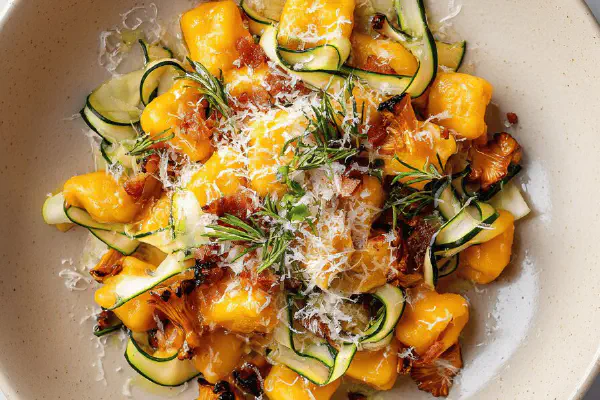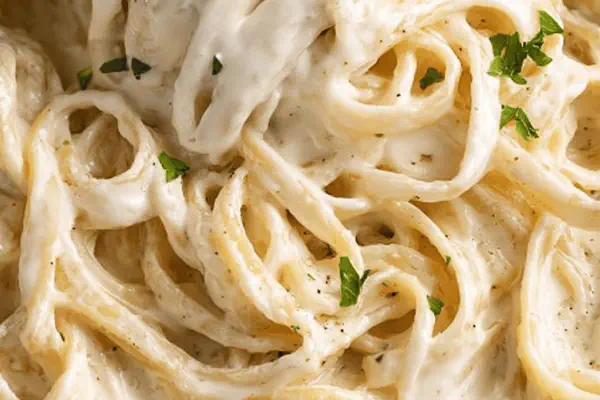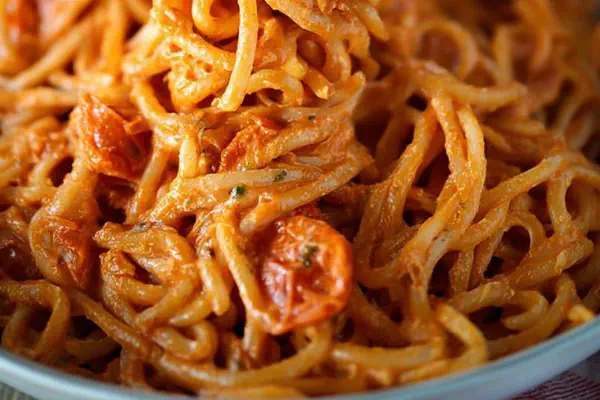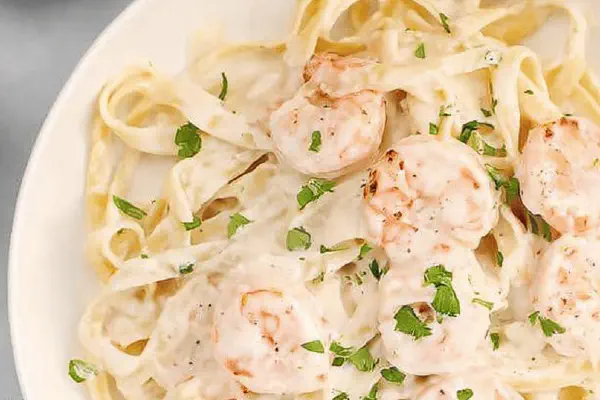Featured Recipe
Gluten-Free Gnocchi Sage Butter
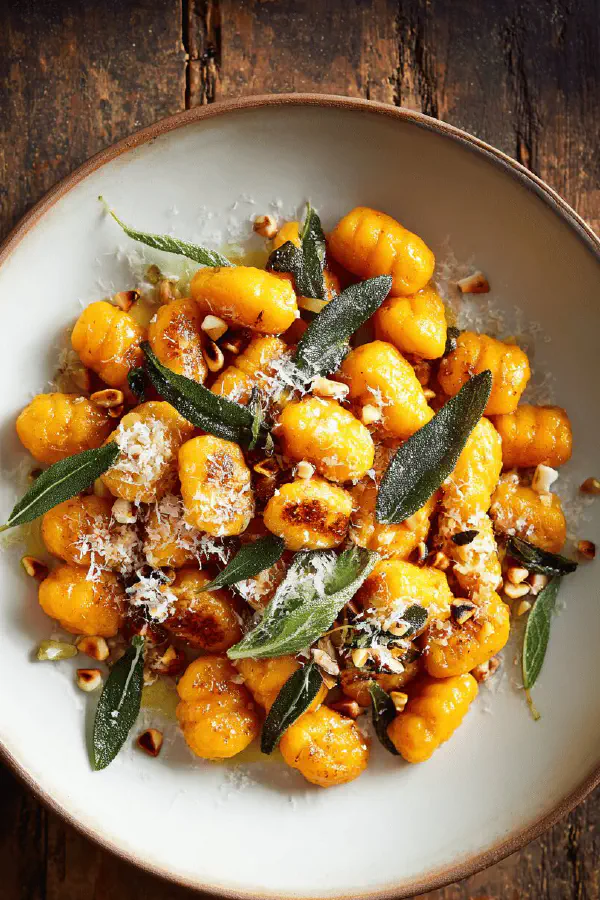
By Kate
"
Gnocchi with a twist: sweet potato replaces Russet for subtle earthiness. Tapioca starch substitutes for fécule de pomme de terre; can’t always get that here. Reworked steps for flow and texture control. Sage butter enriched with browned garlic and toasted pine nuts adds crunch and aroma. Cook gnocchi in small batches—feel the pillowy bounce when done. Crisp sage leaves separately for sharp texture contrast. Simple, clean, foolproof gluten-free gnocchi with layers of flavor and crunch.
"
Prep:
25 min
Cook:
25 min
Total:
50 min
Serves:
4 servings
gnocchi
gluten-free
Italian
pasta
sage butter
Introduction
Mashed sweet potatoes instead of the usual Russet. Why? Earthier, wetter, sweeter—adds complexity. Tapioca starch swapped for potato starch, because it’s silkier, more elastic here. Gnocchi get a lift with sharp pecorino romano, nutmeg’s faint warmth in background. Sage butter doesn’t just coat; it sings with garlicky browned butter and pine nut crunch—unexpected textures. Piping gnocchi straight into simmering water cuts mess and frustration. Watch them float; jiggle with gentle wobble. Precise timing beats guessing. Crispy sage leaves—color contrast and blistered texture, a must. More than a gluten-free nod, a little flavor punch and crunch jazz. Practical, no fluff, just solid pasta foundations and flavor tricks chefs swear by.
Ingredients
About the ingredients
Sweet potatoes bring softness and slightly sticky moisture—ideal when you want gnocchi to bind without too much glue like excess starch. Tapioca starch balances chew with elasticity; it behaves differently than potato starch so test dough in small batch for texture before going full. Pecorino romano is saltier and sharper than parmigiano, fine for stronger flavor. Fresh sage needs crisp-frying not just wilting—crispness adds bite. Garlic isn’t just aromatic but infuses that nutty brown butter base. Pine nuts optional, but bring a toasted crunch that contrasts pillowy texture. Salt at every stage but cautiously because cheese is salty. If you can’t find sweet potato, substitute with Yukon gold mash but reduce starch slightly. Butter better unsalted so you control seasoning, can swap for olive oil blend for dairy-free variation but lose that nutty depth.
Method
Gnocchi
- 1. Whisk eggs and tapioca starch in a bowl until just combined. Warm mashed sweet potatoes should still give slight warmth when touched. Add cheese and nutmeg. Mix gently with wooden spoon. Season with salt and pepper but go easy—cheese salty. The dough must hold shape without being crumbly or sticky. If too wet, dust extra starch sparingly.
- 2. Transfer dough into a piping bag fitted with a plain 1 cm (½ inch) round tip. Have a large pot of salted simmering water ready. Pipe 2.5 cm (1 inch) lengths directly over the water surface. Use a knife or scissors to cut dough log right at the tip. Small batches crucial to avoid sticking.
- 3. Gnocchi will sink first then jiggle free and float—that’s your cue, wait another 3-5 minutes low simmer for fully cooked pillowy texture. Fish them out with a slotted spoon and gently transfer to an oiled tray to keep from sticking. Repeat until all dough is cooked.
- 4. Heat a heavy pan over medium heat; add butter and swirl until it foams and brown specks form, smell nutty (listen for subtle sizzling). Toss in garlic slices, stir 30 seconds—no burn, just golden aroma. Remove garlic slices before they darken too much.
- 5. Add sage leaves; fry until crisp and curled, about 1-2 minutes. Remove sage leaves, drain briefly on paper towels.
- 6. Return gnocchi gently to warm pan with browned garlic butter. Toss carefully to coat without breaking. Toasted pine nuts go in last second for crunch and pine aroma. Season with extra salt and pepper if needed.
- 7. Plate, scatter crispy sage leaves on top. Optional: sprinkle extra grated pecorino. Serve immediately, hot but not scorching.
- 8. Sweet potatoes give moisture, tapioca starch provides elasticity unlike potato starch. Don’t skip cheese; it binds and adds flavor depth.
- 9. Piping saves time and yields uniform gnocchi; you can roll and cut if no piping bag but risk uneven shapes.
- 10. Watch water temp: too hot and gnocchi burst or toughen; simmer gently is key. Floating is your doneness signal—not just a guess.
- 11. Sage butter cooks fast; browned butter flavor crucial, avoid butter burning by watching color and smell closely.
- 12. Pine nuts optional but bring unexpected crunch, toasted to golden before use.
- 13. To rescue sticky dough: chill briefly or add starch sparingly.
- 14. Leftover gnocchi freeze well when spread in single layer on tray then bagged. Reheat in sage butter or boiling water.
Sage Butter
Tips and Techniques
Technique Tips
Piping dough straight over simmering water saves rolling and sticking on work surface. Any generic piping tip about 1 cm works. Cut dough lengths to 2.5 cm—small fosters even cooking without mushiness. Gnocchi floating means air penetrated them; wait 3-5 more minutes low simmer for fullness. Overcooking turns gummy. Watch water: too hot triggers breakage, too cool causes sticking. Browning butter slowly until foaming and nutty aroma develops is crucial for flavor—don’t rush or burn. Garlic slivers add sweetness, pulled early to avoid bitterness. Crispy sage is texture counterpoint not afterthought. Toss gnocchi gently; breakage loses texture charm. Toast pine nuts while gnocchi cook. Serve quickly; gnocchi lose softness as they cool or sit. Leftover gnocchi freeze separately, spaced, to prevent clumping; straight to boiling water for reheating.
Chef's Notes
- 💡 Pasta dough: Achieving the right texture is vital. Add eggs if too dry. If it's sticky, add starch carefully. Always test in small batches before proceeding. Adjusting texture is key.
- 💡 Water temp: Simmering water, not boiling. Too hot and gnocchi can break. Too cool and they sink and stick. Watch them float—3-5 minutes more after floating to ensure cooked through.
- 💡 Browning butter: Patience. Swirl until browned, foamy, nutty smell wafts. Garlic slivers turn quickly, pull before burnt. Sage needs crisping up; don’t crowd the pan.
- 💡 Piping technique: Speeds up cooking, ensures uniform shapes. If rolling and cutting, risk unevenness. Knife works, but piping's cleaner. Cut lengths about 2.5 cm.
- 💡 Storage tips: Freeze unified, single layer. When needed, plunge directly into boiling water. Reheating with sage butter keeps flavors alive. Don’t lose that texture.
Kitchen Wisdom
Why is my gnocchi mushy?
If overcooked, becomes gummy. Mix too wet? Add more starch carefully. Test boiling times; floating must be a gentle jiggle.
Can I use different cheese?
Pecorino brings sharpness. Parmigiano works, but milder flavor. Adjust salt levels if swapping, depends on cheese’s saltiness.
What's the best way to crisp sage?
Fry in hot butter, quick. Drain on paper towels. Need that crunch contrast—no soggy leaves.
Can I make ahead?
Yes, freeze well. Place on baking sheet first. For reheating, do straight into water or skillet with butter. Keeps texture if done right.
